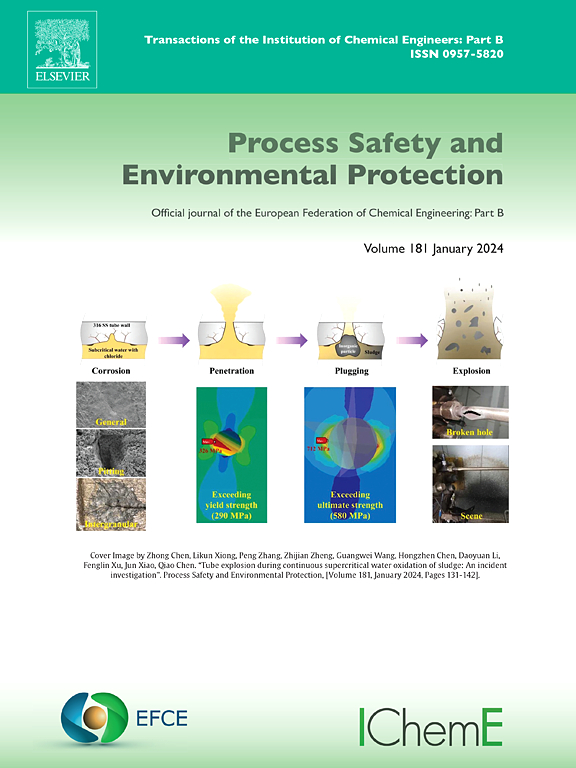Exothermicity analyses and energy efficiency of a novel liquid cooling strategy in suppressing thermal runaway propagation of a lithium-ion battery module
IF 6.9
2区 环境科学与生态学
Q1 ENGINEERING, CHEMICAL
引用次数: 0
Abstract
Thermal runaway propagation (TRP) within lithium-ion battery (LIB) modules has been extensively explored in existing studies, whereas quantitative analyses of exothermic feature of LIBs during TRP and energy efficiency of the related suppression systems are insufficiently investigated. To challenge this issue, a novel liquid cooling system consisting of six n-shaped cold plates is designed to suppress TRP in a LIB module. Effects of mini-channel width (w, 3–12 mm) of cold plates, coolant flow velocity (u, 0.01–0.03 m/s), and type of coolant (mixture of glycol and water with varying glycol mass fractions of 20 %, 50, 80 %, referred to as GS20, GS50, GS80) on cooling performance are examined by developing a 3D numerical model which is verified by experimental measurements. The results show that u= 0.01 m/s delays onset time and peak temperature of TR but fails to suppress TRP regardless of w and coolant type. With fixed u of 0.02 m/s and GS50, cooling performance can be classified into three regimes: (1) TRP region where 3 mm≤w≤ 6 mm; (2) transition region where 6 mm<w< 8 mm and TRP is partially prevented; (3) Non-TRP region where 8 mm≤w. When u= 0.03 m/s, similar phenomena are observed differing in critical w values. Transient heat release rate (HRR) and total released heat (TRH) of a representative LIB as well as the transient nondimensional concentrations and HRRs of the four elemental components in LIB are calculated to quantitively reveal the exothermicity. HRR of LIB exhibits a bimodal feature with the first small peak contributed by decomposition of SEI and the second main peak being ascribed to the other three reactions. LIB temperature, pressure drop, and a new parameter, energy efficiency factor, are analyzed to identify an optimal cooling solution.
一种新型液体冷却策略抑制锂离子电池模块热失控传播的放热性分析和能量效率
现有研究对锂离子电池(LIB)模块的热失控传播(TRP)进行了广泛的探讨,但对锂离子电池(LIB)模块在TRP过程中的放热特性和相关抑制系统的能量效率的定量分析研究不足。为了解决这个问题,设计了一个由六个n形冷板组成的新型液冷系统来抑制LIB模块中的TRP。通过开发3D数值模型,通过实验测量验证了冷板的小通道宽度(w, 3至12 mm),冷却剂流速(u, 0.01至0.03 m/s)和冷却剂类型(乙二醇和水的混合物,乙二醇质量分数为20%,50%,80%,称为GS20, GS50, GS80)对冷却性能的影响。结果表明,无论w和冷却剂类型如何,u=0.01 m/s均能延迟TRP的发生时间和峰值温度,但不能抑制TRP。在固定u为0.02 m/s和GS50的情况下,冷却性能可分为三个区域:(1)TRP区域,3mm≤w≤6mm;(2) 6mm <w<; 8mm和TRP部分阻断的过渡区;(3) 8mm≤w的非trp区域。当u=0.03 m/s时,出现了类似的现象,只是临界w值不同。计算了具有代表性的LIB的瞬态放热率(HRR)和总放热率(TRH),以及LIB中四种元素的瞬态无因次浓度和HRR,定量揭示了LIB的放热特性。LIB的HRR表现出双峰特征,第一个小峰是由SEI分解引起的,第二个主峰是由其他三个反应引起的。分析了LIB温度、压降和新参数能效系数,以确定最佳冷却方案。
本文章由计算机程序翻译,如有差异,请以英文原文为准。
求助全文
约1分钟内获得全文
求助全文
来源期刊

Process Safety and Environmental Protection
环境科学-工程:化工
CiteScore
11.40
自引率
15.40%
发文量
929
审稿时长
8.0 months
期刊介绍:
The Process Safety and Environmental Protection (PSEP) journal is a leading international publication that focuses on the publication of high-quality, original research papers in the field of engineering, specifically those related to the safety of industrial processes and environmental protection. The journal encourages submissions that present new developments in safety and environmental aspects, particularly those that show how research findings can be applied in process engineering design and practice.
PSEP is particularly interested in research that brings fresh perspectives to established engineering principles, identifies unsolved problems, or suggests directions for future research. The journal also values contributions that push the boundaries of traditional engineering and welcomes multidisciplinary papers.
PSEP's articles are abstracted and indexed by a range of databases and services, which helps to ensure that the journal's research is accessible and recognized in the academic and professional communities. These databases include ANTE, Chemical Abstracts, Chemical Hazards in Industry, Current Contents, Elsevier Engineering Information database, Pascal Francis, Web of Science, Scopus, Engineering Information Database EnCompass LIT (Elsevier), and INSPEC. This wide coverage facilitates the dissemination of the journal's content to a global audience interested in process safety and environmental engineering.
 求助内容:
求助内容: 应助结果提醒方式:
应助结果提醒方式:


